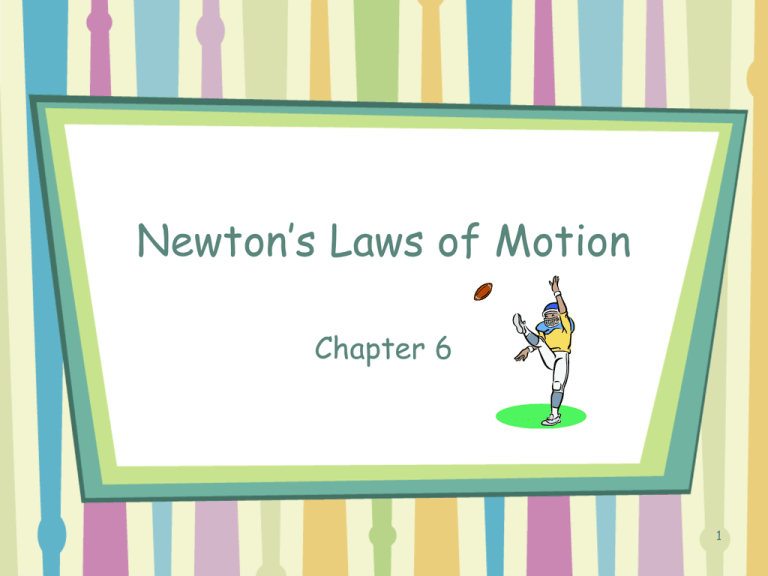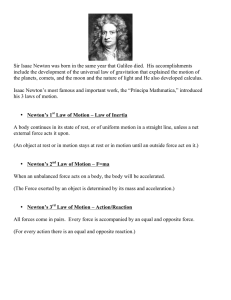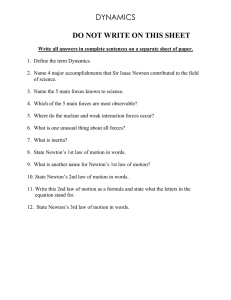Newton’s Laws of Motion Chapter 6 1
advertisement

Newton’s Laws of Motion Chapter 6 1 Causes of Motion •Aristotle (384-322 BC) believed that all object had a “natural place” and that the tendency of an object was to reside in its “natural place.” •All objects were classified into categories of earth, water, air, or fire. •“Natural motion” occurred when an object sought to return to its “natural place” after being moved from it by some type of “violent motion.” •To keep an object moving would require a force. 2 These views remained widely supported until the 1500s when Galileo Galilei (1564-1642) popularized experimentation. Isaac Newton (1642–1727) proposed that the tendency of an object was to maintain its current state of motion. 3 Sir Isaac Newton (1642 – 1727) • Built on Galileo, Kepler, and others • Worked out the “three laws of motion” governing the movement of all objects at all times an in all circumstances. • He published them in his book Philosophiae Naturalis Principia Mathematica (mathematic principles of natural philosophy) in 1687. 4 Sir Isaac Newton – 1st Law – an object at rest or in motion stays at rest or in motion unless acted upon by an outside force * Known as the “Principle of Inertia” – 2nd Law – describes how an object accelerates or changes direction when a force is applied to it * F = ma – 3rd Law – for action there is an equal and opposite reaction 5 What is a Force? • Force can be defined as a push or a pull. – (Technically, force is something that can accelerate objects.) • Force is measured by N (Newton). 1 Newton = kg * m/s2 • A force that causes an object with a mass of 1 kg to accelerate at 1 m/s is equivalent to 1 Newton. 6 What are the types of Forces? Type of Force Force Symbol Contact Friction Ffric or Ff Contact Normal FN Contact Applied FAppl Contact Spring FS Contact Tension FT Contact Thrust Fthrust Long-Range Weight Fgrav 7 8 Contact Forces vs. Long-Range Forces – Contact Force = acts on an object only by touching it. (ie. Books resting on a desk) – Long-Range Force = forces that are exerted without contact or forces resulting from actionat-a-distance, (ie. force of gravity). – Types of Forces = see Table 6-2 in your books! 9 Forces have Agents – Each force has a specific, identifiable, immediate cause called the agent. – How to solve for agents: – 1. Create a pictorial model of situation. – 2. Circle the system and identify every place where the system touches the environment. – 3. It is at these places that contact forces are exerted. – 4. Then identify any long-range forces on the system, ie. Force of gravity (Fgrav). 10 Example of Forces having Agents A physics book resting on a desk. 11 Newton’s 1st Law of Motion “Law of Inertia” • An object at rest tends to stay at rest and an object in motion tends to stay in motion with the same speed and in the same direction unless acted upon by an unbalanced force. (outside force) The velocity of an object remains constant unless acted on by an unbalanced force. 12 Newton’s 1st Law of Motion 13 Newton’s 1st Law of Motion • • Inertia - the resistance an object has to a change in its state of motion. [Newton’s 1st Law] Equilibrium - if the net force on an object is zero, then it is said to be in equilibrium. – An object is in equilibrium when: at rest or moving at constant velocity. 14 15 16 Some Examples from Real Life A soccer ball is sitting at rest. It takes an unbalanced force of a kick to change its motion. Two teams are playing tug of war. They are both exerting equal force on the rope in opposite directions. This balanced force results in no change of motion. 17 Net Force • • After you have added and subtracted all the forces you are left with the net force acting on the object. There are several common forces acting on objects that you need to memorize: Force Symbol Friction Ffric or Ff Normal FN Applied FAppl or Fa Net FNet Weight Fgrav or Fg 18 Free Body Diagrams • To keep track of how all these forces are affecting a single object, it is a good idea to draw a free body diagram. • A free body diagram is just a simple sketch of the object showing all the forces that are acting on it. – Draw a quick sketch of the object. – Draw an arrow showing every force acting on the object. – To calculate the net force, add any vectors acting on the same axis (x and y), making sure to pay attention to the directions. 19 Examples of Free Body Diagrams 20 Examples of FNet 21 Examples of FNet 22




